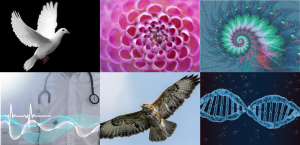Mathematical Biology

Research interests of the Mathematical Biology Group include modelling the spread of infectious diseases in populations, statistical and machine learning models to assess relationships between biological variables, statistical genetics, and other topics.
The Group hosts a joint seminar series with the School of Life, Health and Chemical Sciences on Mathematical and Theoretical Biology.
Statistical genetics and AI
This research involves applying statistical tools to link genetic data to various biomedical characteristics, such as our appearance: skin colour, face shape, etc. Such tools are also use to analyse gene expression, RNAseq, and epigenetic data.
We build mathematical prediction models that are useful in forensic reconstruction of a person’s appearance when only DNA is available.
We are using AI (artificial intelligence) tools to automatically extract features from people’s photos, or to modify them for forensics.
Biophysics - Cardiovascular systems and diseases, Models of living tissues
This research involves developing optimisation techniques for predicting the structures of vasculatures and self-organisation in tissues due to interactions between cells and the extracellular matrix. New mathematical models are also developed for the simulation of embolic stroke.
Modelling the spread of infectious diseases
This research relates mainly regarding deterministic systems of equations to model the spread of infectious diseases at a population level, in both human and animal populations. It also involves modelling animal movement and range expansion in different species.
Modelling relationships between biological variables
We use traditional statistical and machine learning models to assess relationships between biological variables including genetics, epigenetics, metabolites and the microbiome and health and disease. From these relationships we can better predict and understand the mechanisms of health and disease.
Computational neuroscience
This research involves research on mathematical / computational neuroscience focused on the quantification of information encoding and processing in neural systems. That was achieved by mathematical modelling and data analysis using and developing methods based on information theory. The target systems ranged from the information processing properties of single neurones to communication across whole brain areas.
Probabilistic modelling in foraging
This work involves using probabilistic models to describe animal foraging behaviours in order to understand the role that randomness plays in food accumulation. Using data from animal-attached technologies we can better understand how well such models fit to real animal behaviours and how randomness can affect long term breeding success.
Fluid dynamics in human physiology
This research involves the application of mathematics to address problems involving human biology. A PhD student is currently examining the mathematics of cerebrospinal fluid flow and therefore is very interested in exploring the application of fluid dynamics in human physiology.
Mathematical Biology Group
Central Academics
Kaustubh Adhikari
Jim Hague
Marc Pradas
Yonas Weldeselassie
Staff Tutors
Colette ChristiansenMarcelo Montemurro
Andrew Neate

